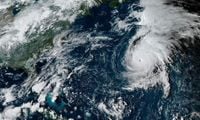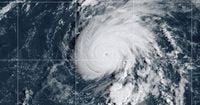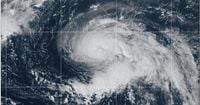On Monday, September 22, 2025, Hurricane Gabrielle roared through the central Atlantic, making headlines as the second major hurricane of the 2025 Atlantic season. The storm, which rapidly intensified into a powerful Category 4 system, reached maximum sustained winds of 140 mph, according to the National Hurricane Center (NHC). For residents of Bermuda, the Azores, and the U.S. East Coast, Gabrielle’s trajectory has been a closely watched development, though—at least for now—the system does not pose a direct threat to land.
Gabrielle’s rapid escalation was no small feat. According to ABC News, the hurricane became the second tropical system of the season to undergo such swift intensification. The NHC confirmed that, as of 5 p.m. EST on September 22, Gabrielle was located about 180 miles east-southeast of Bermuda and roughly 2,005 miles west of the Azores. The storm was moving north-northeast at 12 mph, a pace expected to pick up in the coming days as Gabrielle pushes farther into the open Atlantic.
For Bermuda, the news was something of a relief. The hurricane’s center was forecast to pass east of the island, keeping the worst of the rain and wind at bay. Still, the NHC and NOAA warned that large swells and dangerous rip currents would batter the island’s shores through early in the week. These warnings were echoed by Riviera Maya News, which reported that “sea swells are likely to cause life-threatening surf and rip current conditions.” The U.S. East Coast, from the Jersey Shore down to the Carolinas and even parts of Florida, braced for similar hazards, with high risk of rip currents expected on Monday.
As Gabrielle churned through warm Atlantic waters, forecasters kept a keen eye on its future path. The NHC anticipated that the storm could strengthen a bit more on Monday, but a gradual weakening was expected to begin by Tuesday and continue through Wednesday. Despite its formidable power, the hurricane was not predicted to intensify beyond Category 4. In fact, “slight weakening is expected Tuesday,” the NHC stated. The storm’s trajectory would take it northeast, out toward the central Atlantic, and possibly along or north of the Azores by Thursday night or Friday.
The Azores, a group of islands west of Portugal, found themselves in the hurricane’s potential path, though the exact magnitude of wind, rainfall, and wave impacts remained uncertain. “Interests in the Azores should monitor the progress of Gabrielle though it is too soon to specify the magnitude of potential wind, rainfall, and wave impacts,” the National Hurricane Center cautioned. By late Monday, local officials urged residents to keep a close eye on advisories, as the system’s approach was still several days away.
Despite the lack of direct landfall threats, Gabrielle’s influence was felt far and wide. Swells generated by the hurricane reached Bermuda on Sunday, September 21, and were already impacting the U.S. East Coast from North Carolina northward to Canada’s Atlantic provinces. The National Hurricane Center and NBC Miami both emphasized that these swells were likely to cause “life-threatening surf and rip current conditions.” For beachgoers and coastal communities, the message was clear: exercise caution and heed local warnings.
Gabrielle’s rapid intensification was notable for another reason—it fit neatly into the statistical expectations for the Atlantic hurricane season. According to ABC News, the second major hurricane typically forms around September 19, so Gabrielle’s timing was right on the mark. Yet, as NBC Miami pointed out, this year’s hurricane season had been relatively quiet up until this point, with only one other named hurricane preceding Gabrielle. Experts say that while a slow start can lull coastal residents into a sense of security, it doesn’t mean that dangerous storms won’t form later in the season. Indeed, the Atlantic hurricane season doesn’t officially end until November 30.
NOAA’s Hurricane Hunter aircraft and satellite data provided a detailed snapshot of Gabrielle’s power: hurricane-force winds extended outward up to 40 miles from the center, while tropical-storm-force winds reached as far as 140 miles. The Riviera Maya News highlighted that, while no coastal watches or warnings were in effect as of Monday, the sheer size and strength of the storm’s wind field meant that even areas far from the center could feel its effects through rough surf and hazardous marine conditions.
For now, the United States mainland can breathe a sigh of relief. As of September 22, 2025, Gabrielle did not pose a direct threat to the U.S., and the storm’s projected path keeps it well offshore. However, the indirect impacts—especially the risk of rip currents—are not to be underestimated. The NHC advised that “potentially life-threatening surf” would affect areas from North Carolina northward, including parts of Atlantic Canada, over the next two days.
Looking ahead, forecasters will continue to monitor Gabrielle’s progress as it accelerates toward the northeast and potentially nears the Azores by the end of the week. The NHC planned to issue its next advisory at 8 a.m. Tuesday, and local authorities in the Azores were preparing contingency plans, even as the exact impacts remained uncertain. The importance of vigilance in hurricane season cannot be overstated—especially when storms like Gabrielle can change course or intensity with little warning.
For residents of Bermuda and the Azores, as well as communities up and down the East Coast, the story of Hurricane Gabrielle serves as a timely reminder of the power and unpredictability of nature. With the Atlantic hurricane season far from over, meteorologists and emergency officials alike urge everyone in potentially affected regions to stay informed, heed advisories, and take every precaution. After all, when it comes to hurricanes, it’s always better to be safe than sorry.
As Hurricane Gabrielle continues its journey across the Atlantic, the world watches—a stark illustration of how even storms that never make landfall can leave a lasting mark on the lives and landscapes in their path.



